A Certificate of Conformance, also known as a Certificate of Compliance or a Conformance Certificate, is a document that verifies that a product or system meets a set of established specifications or standards. This certificate is issued by the manufacturer, supplier or testing agency to assure the customer that the product is of quality standard and conforms to the safety and performance requirements set by the regulatory authorities.
The certificate is an important document as it provides a level of assurance to customers, regulators and other stakeholders that the product or system has been independently verified and meets the specified requirements. In this article, we will delve deeper into the concept of a Certificate of Conformance, its importance, types, and the process of obtaining one.
Table of Contents
Certificate of Conformance Templates
A Certificate of Conformance (CoC) Template is a document used to certify that a product, service, or process complies with specified standards, regulations, or requirements. It serves as a formal declaration by the manufacturer, supplier, or provider that the item or service meets the necessary criteria and has undergone the required testing, inspection, or validation procedures. Certificate of Conformance Templates ensure consistency, accuracy, and transparency in verifying compliance and providing assurance to customers, regulatory bodies, and stakeholders.
Certificate of Conformance Templates are widely used in various industries, including manufacturing, construction, healthcare, and service sectors. They play a crucial role in ensuring quality control, regulatory compliance, and customer satisfaction. By using these templates, organizations can streamline the process of issuing certificates, maintain consistency in documenting conformance, and provide transparent evidence of compliance to customers, regulatory bodies, and other stakeholders. Certificate of Conformance Templates enhance trust, facilitate trade relationships, and demonstrate a commitment to meeting quality standards and regulatory requirements.
History of Certificates of Conformance

The concept of a Certificate of Conformance has its roots in the industrial revolution of the 19th century, when mass production of goods began to take place. As the manufacturing process became more complex and the demand for goods increased, ensuring the quality and safety of products became a major concern. In response to this, various standards and regulations were established to ensure that products met certain criteria for quality and safety.
The first official certificate of conformance was issued in the early 20th century, as a means for manufacturers to demonstrate that their products met these newly established standards. The certificate was issued by a third-party testing agency or a government organization, and provided assurance to customers that the product was safe and met the required standards.
Over the years, the concept of a Certificate of Conformance has evolved and expanded to include a wide range of industries and products. Today, certificates of conformance are commonly used in fields such as construction, manufacturing, and engineering, and are required by many regulatory agencies and standards organizations.
In summary, the certificate of conformance emerged as a way to ensure that products met safety and quality standards, as mass production increased and regulations were put in place. It evolved over the years to cover a wide range of products and industries, becoming an important document for manufacturers and customers alike.
What is the Purpose of a Certificate of Conformance?
The purpose of a Certificate of Conformance is to verify that a product or system meets a set of established specifications or standards. This certificate provides assurance to customers, regulators and other stakeholders that the product or system has been independently verified and meets the specified requirements, ensuring that the product is of quality standard and conforms to the safety and performance requirements set by the regulatory authorities.
A certificate of conformance helps to ensure that products are safe for use and meet industry standards, which helps to protect the public from unsafe products and also provides a level of quality assurance to customers. This is especially important in industries where products and systems must meet specific safety and performance requirements, such as construction, healthcare, and transportation.
Additionally, a certificate of conformance can also be used as a marketing tool, as it demonstrates that a company’s products meet industry standards and can help to establish trust and credibility with customers.
What Details Are Included In the Certificate of Conformance?
A Certificate of Conformance typically includes the following information:
Product or system information: The certificate should include detailed information about the product or system being certified, such as the model number, serial number, and any other identifying information.
Standards or specifications met: The certificate should specify the standards or specifications that the product or system has been tested against and has been found to meet.
Testing and inspection details: The certificate should include information about the testing and inspection process, such as the test methods used, the test results, and the date of testing.
Issuing organization: The certificate should include the name and contact information of the organization that issued the certificate, as well as any accreditation or certification information.
Signature: The certificate should be signed by an authorized representative of the issuing organization.
Expiration date: Some certificates may have an expiration date, in which case it should be clearly stated on the certificate.
Manufacturing details: The certificate should include information about the manufacturer, such as the company name, address, and contact information.
Additional information: Depending on the product or system, the certificate may also include additional information such as any warranty or guarantee information, safety warnings, or instructions for use.
How Do I Get a Certificate of Conformance?
Obtaining a Certificate of Conformance typically involves the following steps:
Identify the appropriate standards or specifications: Before you can obtain a certificate of conformance, you need to identify the appropriate standards or specifications that your product or system must meet. This information can typically be found from industry associations, regulatory bodies or standards organizations.
Have your product or system tested: Once you have identified the appropriate standards, you will need to have your product or system tested by an organization that is qualified to issue certificates of conformance. This organization may be a third-party testing agency or a government organization.
Provide necessary documentation: You will need to provide the testing organization with the necessary documentation, such as test reports, product specifications, and any other relevant information.
Pay required fees: You will need to pay any required fees to the testing organization for their services.
Receive the certificate: If your product or system passes the testing, the testing organization will issue a certificate of conformance.
Keep the certificate up to date: You will need to keep the certificate up to date by renewing it when it expires or when significant changes are made to the product or system.
What’s the Difference: Compliance vs Certification
Indicate that a product or system meets a set of established standards or specifications. However, there are some key differences between the two.
A Certificate of Compliance, also known as a Compliance Certificate, is a document that verifies that a product, process, or service conforms to a set of regulations or laws. It is usually issued by a government agency or regulatory body and attests that the product, process, or service complies with the relevant laws or regulations.
A Certificate of Conformance, on the other hand, is a document that verifies that a product or system conforms to a set of industry standards or specifications. It is usually issued by a third-party testing agency, industry association, or other certifying organization and attests that the product or system meets the relevant standards or specifications.
In summary, while both certificates are used to ensure that products and systems meet established standards, a certificate of compliance verifies that a product or system meets legal or regulatory requirements, while a certificate of conformance verifies that a product or system meets industry standards or specifications.
Uses of Certificate of Conformance
Quality Assurance: One of the main uses of a certificate of conformance is to provide assurance to customers, regulators, and other stakeholders that a product or system meets a set of established standards or specifications. This helps to ensure that the product is of good quality and conforms to the safety and performance requirements set by the regulatory authorities.
Compliance with Industry Standards: A certificate of conformance can be used to demonstrate that a product or system meets industry standards, which can be especially important in industries where products and systems must meet specific safety and performance requirements, such as construction, healthcare, and transportation.
Meeting Regulatory Requirements: A certificate of conformance can be used to demonstrate that a product or system meets the safety requirements of regulatory bodies, such as OSHA, FCC, or FDA. This is important for companies that operate in regulated industries, as it can help them comply with legal requirements and avoid penalties for non-compliance.
Marketing Tool: A certificate of conformance can also be used as a marketing tool, as it demonstrates that a company’s products meet industry standards and can help to establish trust and credibility with customers.
Import and Export: A certificate of conformance is also important when importing or exporting products. Many countries have regulations that require imported products to meet certain safety and performance standards, and a certificate of conformance can be used to demonstrate that the product meets these requirements.
Insurance and liability: Having a certificate of conformance can help reduce the risk of liability for manufacturers and distributors of products. By demonstrating that a product meets industry standards, it can help to reduce the risk of liability in the event of a product failure or defect.
Warranty and guarantee: A certificate of conformance can also be used as part of a warranty or guarantee program. By demonstrating that a product meets industry standards, it can help to ensure that customers receive a high-quality product and can help to increase customer satisfaction.
Countries which Require a Certificate of Conformance ?
A certificate of conformance, also known as a certificate of compliance or certificate of conformity, is a document that certifies that a product meets certain standards or regulations. The specific requirements for a certificate of conformance can vary depending on the country and the product in question.
In the European Union, for example, many products must have a CE mark, which stands for “Conformité Européene” and indicates that a product meets EU health, safety, and environmental protection requirements. The CE mark is required for a wide range of products, including toys, electrical equipment, machinery, medical devices, and personal protective equipment.
In the United States, the Federal Communications Commission (FCC) requires certain electronic devices, such as cell phones and computers, to have an FCC compliance label. This label indicates that the device has been tested and meets FCC technical standards for radio frequency emissions.
In Canada, the Canadian Standards Association (CSA) is responsible for certifying many products, including electrical equipment, appliances, and gas-fired equipment. Products that have been certified by the CSA bear a CSA mark, which indicates that they meet Canadian safety standards.
In Australia, the Australian Communications and Media Authority (ACMA) is responsible for certifying electronic devices, including radios, televisions, and telecommunication equipment. The ACMA mark indicates that the device has been tested and meets Australian standards for radio frequency emissions.
In New Zealand, the Ministry of Business, Innovation and Employment (MBIE) is responsible for certifying many products, including electrical equipment, appliances, and gas-fired equipment. Products that have been certified by the MBIE bear an MBIE mark, which indicates that they meet New Zealand safety standards.
In Japan, the Ministry of Economy, Trade and Industry (METI) is responsible for certifying many products, including electrical equipment, appliances, and gas-fired equipment. Products that have been certified by the METI bear a METI mark, which indicates that they meet Japanese safety standards.
In Brazil, the Inmetro is responsible for certifying many products, including electrical equipment, appliances, and gas-fired equipment. Products that have been certified by the Inmetro bear a Inmetro mark, which indicates that they meet Brazilian safety standards.
In China, the China Compulsory Certification (CCC) mark is required for a wide range of products, including electrical equipment, appliances, and telecommunications equipment. The CCC mark indicates that the product has been tested and meets Chinese safety and performance standards.
In India, the Bureau of Indian Standards (BIS) is responsible for certifying many products, including electrical equipment, appliances, and gas-fired equipment. Products that have been certified by the BIS bear a BIS mark, which indicates that they meet Indian safety standards.
In Russia, the Gosstandart of Russia is responsible for certifying many products, including electrical equipment, appliances, and gas-fired equipment. Products that have been certified by the Gosstandart of Russia bear a Gosstandart of Russia mark, which indicates that they meet Russian safety standards.
In South Africa, the South African Bureau of Standards (SABS) is responsible for certifying many products, including electrical equipment, appliances, and gas-fired equipment. Products that have been certified by the SABS bear a SABS mark, which indicates that they meet South African safety standards.
FAQs
Who issues a certificate of conformance?
Certificates of conformance can be issued by a variety of organizations, such as government agencies, industry associations, and third-party testing and certification bodies.
What are some examples of products or systems that may require a certificate of conformance?
Examples of products or systems that may require a certificate of conformance include electrical equipment, medical devices, construction materials, and vehicles.
How long is a certificate of conformance valid?
The validity of a certificate of conformance depends on the specific standards or regulations that the product or system meets, as well as any expiration date specified on the certificate. Some certificates may be valid indefinitely, while others may need to be renewed or re-certified on a regular basis.
Is a certificate of conformance required for all products or systems?
No, a certificate of conformance is not required for all products or systems. It depends on the specific industry and regulations that the product or system falls under. Some industries may have mandatory requirements for certification, while others may not.
Can a certificate of conformance be revoked?
Yes, a certificate of conformance can be revoked if it is found that the product or system no longer meets the standards or regulations that it was originally certified for, or if the certification body discovers any fraud or misrepresentation in the certification process.
How can I obtain a certificate of conformance for my product or system?
You can obtain a certificate of conformance by submitting your product or system to a testing and certification body that is accredited to certify products or systems to the specific standards or regulations that you need to meet. The testing and certification body will then perform the necessary testing and evaluation, and if the product or system meets the requirements, they will issue a certificate of conformance.
How do I know if a certificate of conformance is valid?
You can check the validity of a certificate of conformance by contacting the issuing organization or certification body and verifying that the certificate is still valid and has not been revoked. Some certification bodies may also provide an online database or registry where you can look up the status of a certificate.














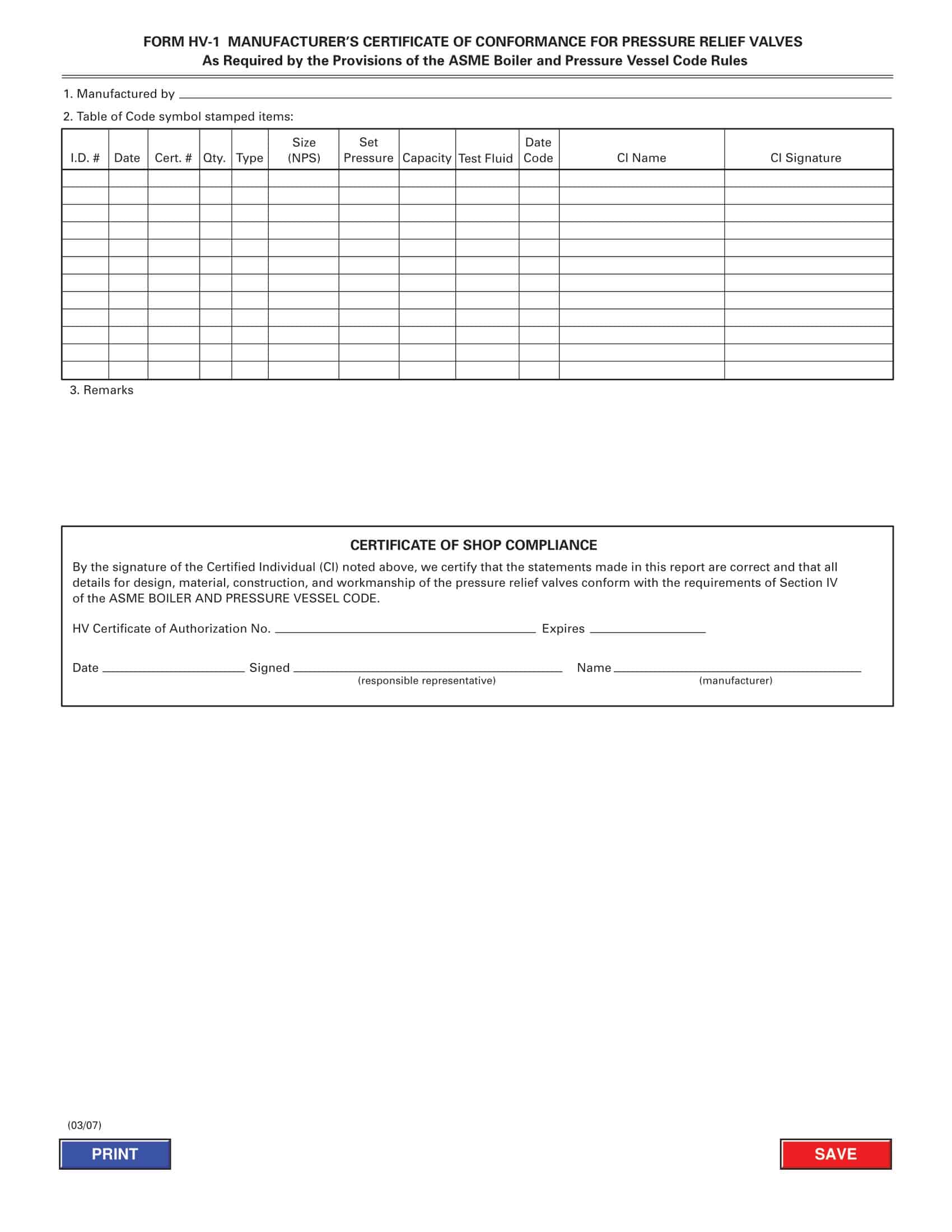







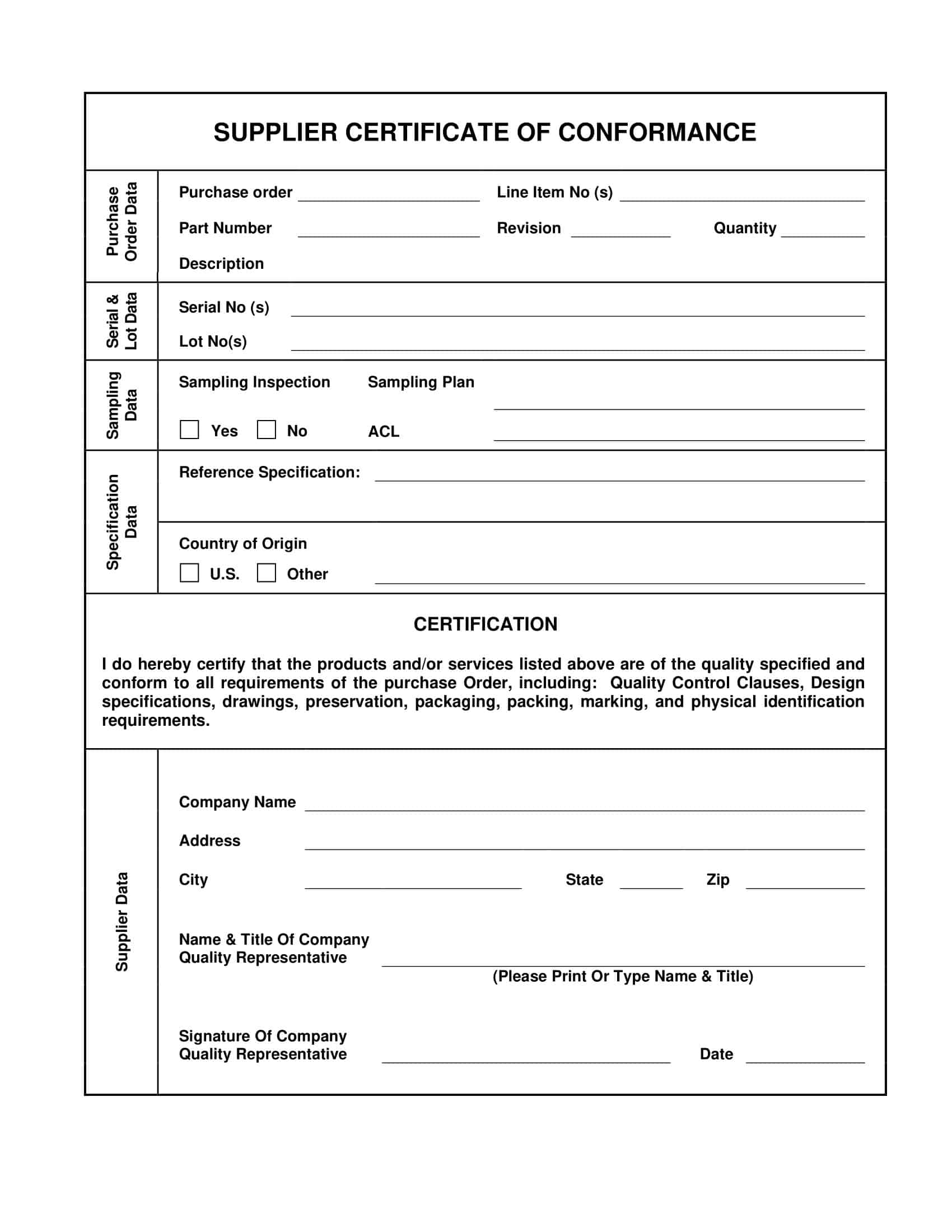



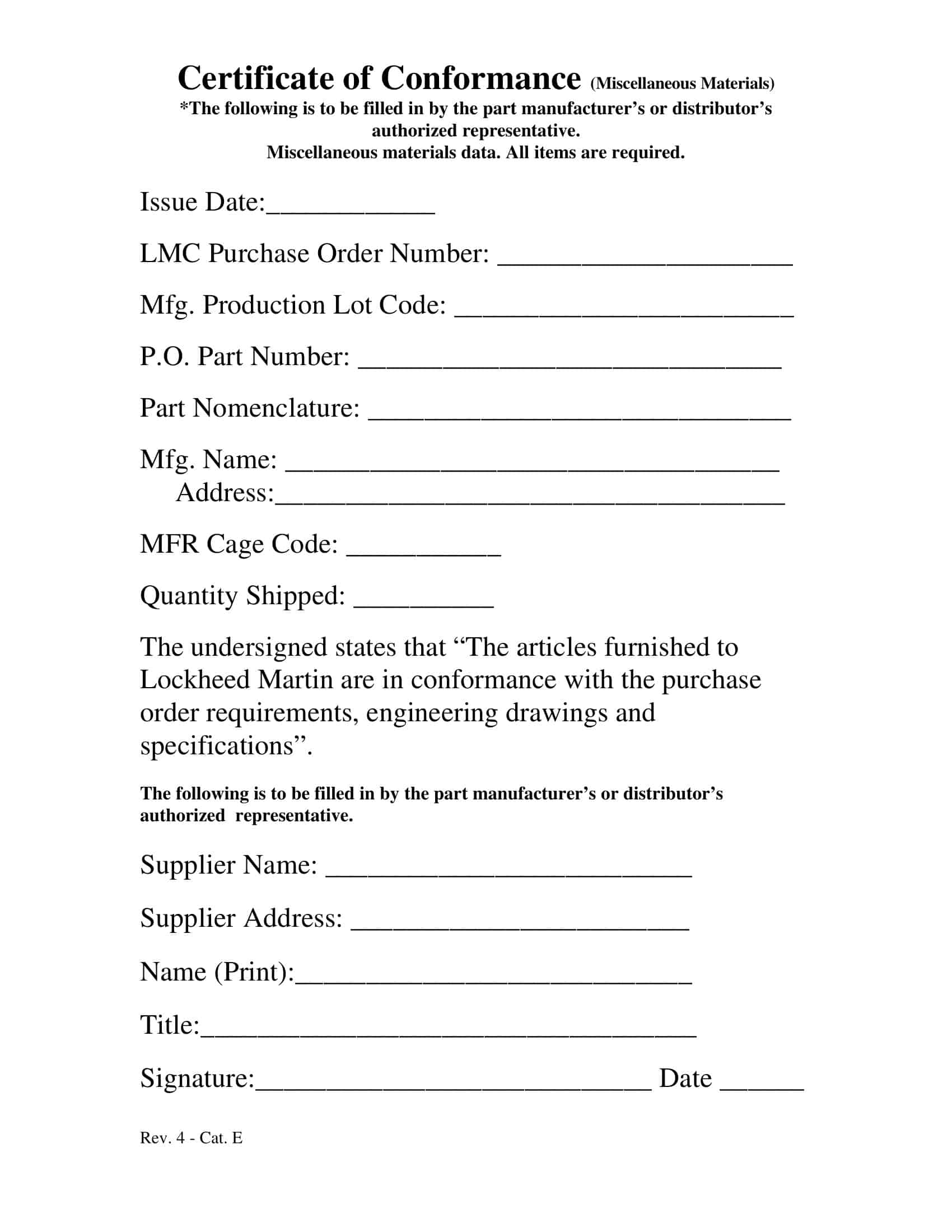



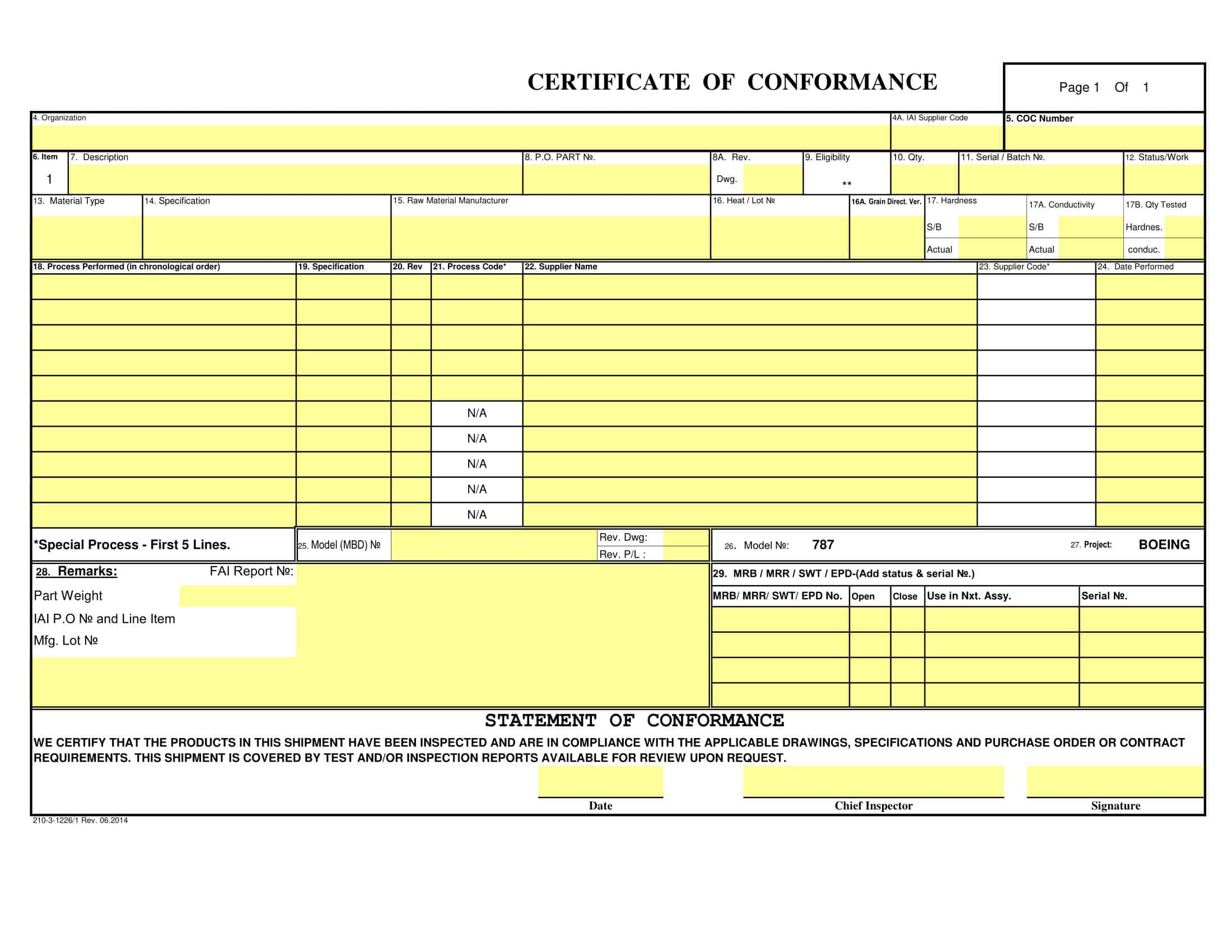











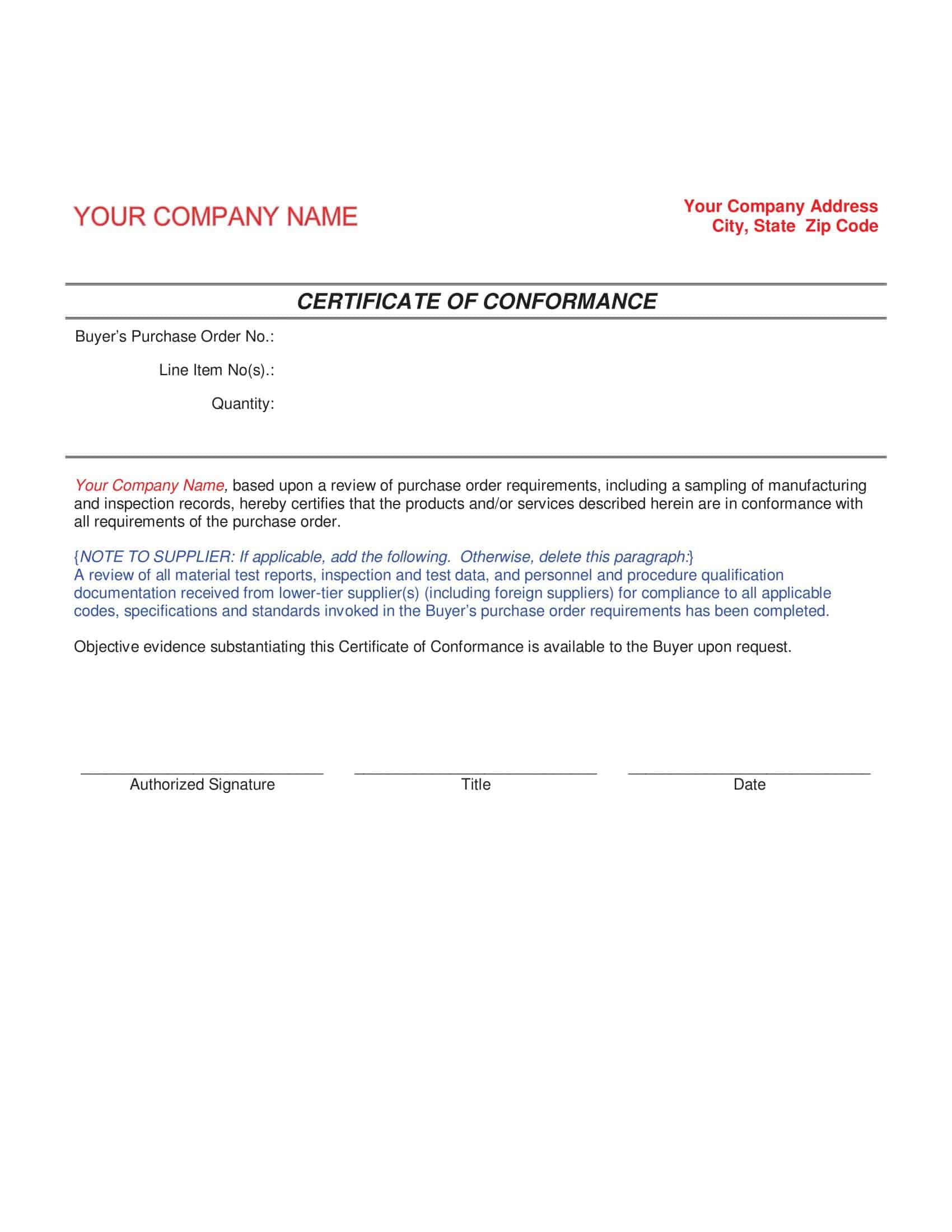





![Free Printable Estoppel Certificate Templates [PDF, Word] Tenant 1 Estoppel Certificate](https://www.typecalendar.com/wp-content/uploads/2023/05/Estoppel-Certificate-1-150x150.jpg)
![Free Printable Roommate Agreement Templates [Word, PDF] 2 Roommate Agreement](https://www.typecalendar.com/wp-content/uploads/2023/06/Roommate-Agreement-150x150.jpg)
![Free Printable Credit Card Authorization Form Templates [PDF, Word, Excel] 3 Credit Card Authorization Form](https://www.typecalendar.com/wp-content/uploads/2023/06/Credit-Card-Authorization-Form-150x150.jpg)
